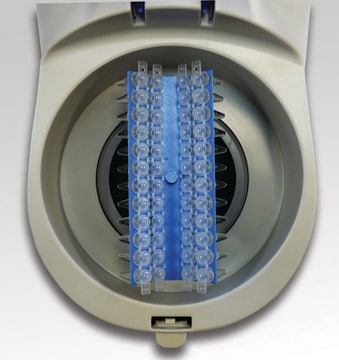Z742581
Mini-Centrifuge with 2 rotors
red, AC/DC input 230 V AC, UK plug
Synonym(s):
benchmark Scientific mini centrifuge, microfuge, personal centrifuge
About This Item
Recommended Products
material
plastic lid
feature
CE compliant
to hold 16 0.2 mL tubes
to hold 2 8 PCR strips
to hold 6 1.5/2.0 Ml tubes
packaging
pkg of 1
manufacturer/tradename
Benchmark Scientific BSC1006-R-E-UK
parameter
6600 rpm speed
technique(s)
centrifugation: suitable
weight
2.2 lb
color
red
clear lid
Looking for similar products? Visit Product Comparison Guide
Related Categories
General description
The Benchmark Scientific BSC1006-B centrifuge operates at 115V/60Hz with a temperature range from 4 degrees C to 50 degrees C. It spins up to 6,600 RPM and is blue in color. The centrifuge measures 3.9 x 5.0 x 5.4 inches/10.0 x 12.6 x 13.8 cm (H x W x D). (H is height, the vertical distance from lowest to highest point; W is width, the horizontal distance from left to right; D is depth, the horizontal distance from front to back.)
A centrifuge is used to spin fluids of different densities to separate various parts, commonly blood and DNA samples. Centrifuges are composed of the main body or housing and a spinning rotor. Tubes of cellular material suspended in liquid are inserted into the rotor and spun at various speeds to separate components. Centrifuges are used in medical, industrial, and research laboratories, as well as academic and clinical settings.
What′s in the Box?
Benchmark Mini-Centrifuge
Fixed-angle, six-place rotor
PCR strip tube rotor
(6) adapters for additional sample tube sizes
rotor removal key
Certificates of Analysis (COA)
Search for Certificates of Analysis (COA) by entering the products Lot/Batch Number. Lot and Batch Numbers can be found on a product’s label following the words ‘Lot’ or ‘Batch’.
Already Own This Product?
Find documentation for the products that you have recently purchased in the Document Library.
Our team of scientists has experience in all areas of research including Life Science, Material Science, Chemical Synthesis, Chromatography, Analytical and many others.
Contact Technical Service







